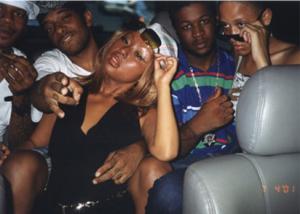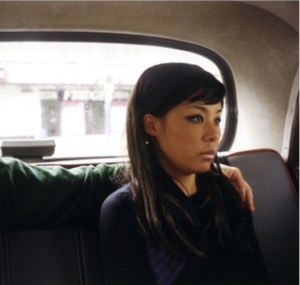 Nikki. S Lee’s Part (14) (2002) depicts an attractive Asian woman in dark makeup and smart attire sat in the back of a car. She has, what appears to be, a man’s arm around her. Due to her staring/arguably sombre expression and unapparent identity of the owner of this arm, my first thoughts are that this presence is an ominous one. Especially as he is sat so far from her despite lack of seatbelt. The name suggests that this is a part of a series, perhaps a story or film stills.
Nikki. S Lee’s Part (14) (2002) depicts an attractive Asian woman in dark makeup and smart attire sat in the back of a car. She has, what appears to be, a man’s arm around her. Due to her staring/arguably sombre expression and unapparent identity of the owner of this arm, my first thoughts are that this presence is an ominous one. Especially as he is sat so far from her despite lack of seatbelt. The name suggests that this is a part of a series, perhaps a story or film stills.
Nikki is an artist that echoes some behaviours of Cindy Sherman, adopting different personalities and identities to create her photographs. However, unlike Cindy Sherman, she investigates different social groups within her work by spending a certain amount of time with them, completely changing her appearance every time, Photographs of her and members of the group are consequently taken, an example being the HipHop Project (2001).
So, for her ‘Parts’ project, she used a collection of photos of her boyfriend and herself, and physically cropped him out of every one. By doing so, she isolates herself and forces attention of the spectator onto details such as her body language. They’re therefore forced to look for more information, so despite the absence of his identity , the subject of this body of work becomes the story of the relationship. However, because of her practice, it makes me question the validity of her emotions. Is this all set up? Is she forcing a narrative into the picture? The fact that most of her facial expressions display some sort of emotional conflict suggest this, in my opinion, people tend to pose with a smile when they know a picture is being taken.
Brittany Carpenter for National Museum of Women in the Arts. (2013). Fluid Identities: The “Parts” and “Projects” of Nikki Lee. [online] Available at: https://nmwa.org/blog/2013/11/01/fluid-identities-the-parts-and-projects-of-nikki-lee/ [Accessed 24 Oct. 2017].
